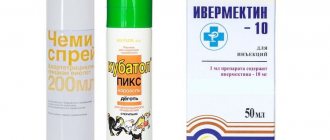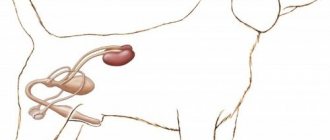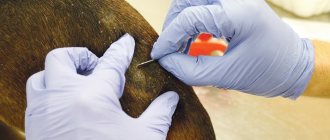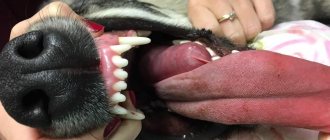About the parasite
Otodectosis in dogs is caused by ear mites, a representative of the subclass of arthropods of the arachnid class, which breeds in a warm, humid environment. It is for this reason that the pest lives in the ear canal of dogs, using particles of the epidermis, earwax and even the blood of the animal as food.
The oval-shaped parasite has a light beige color, resembling a crab in appearance. Its body length is about 0.5 mm.
On a note!
Feeding on lymph, it gnaws many passages on the inside of the ear. In them, the female ear mite lays eggs, from which adult individuals emerge after 18-25 days.
In the absence of favorable conditions, the parasite remains viable for 22 days. In an environment at a temperature of 3-7 degrees and high humidity, it lives up to 25 days. Low temperatures are destructive for small creatures: at temperatures below -3 degrees, the pest dies within 5 days (you can see what the parasite looks like in the photo below).
Description and danger to the dog
These are small parasites, the size of which does not exceed 1 mm. They have a translucent gray body. They have a well-developed oral apparatus, which allows them to gnaw through the skin and passages for parasitism under the epidermis. The waste products of ticks cause inflammation and suppuration of wounds.
Females lay eggs in the subcutaneous passages, which quickly develop into larvae. Already at the larval stage, individuals need food. Their diet consists of lymphatic fluid from the products of putrefaction. It takes about 3-4 weeks for the larva to develop into a sexually mature young individual that is capable of laying eggs.
It takes very little time for parasites to damage the skin of the ear and eardrum. If no action is taken, the mite begins to infect the inner ear, and then penetrates the animal’s brain. It is almost impossible to identify the parasite immediately after infection. Owners pay attention to symptoms when parasites affect a significant part of the skin. You can see what a tick looks like in the photo.
It is worth remembering that when infected with ear mites, some cyclical activity of the parasites may be observed. There are periods when the symptoms are pronounced, then there is a period of rest, during which the symptoms almost disappear and one might think that the disease goes away on its own, but this is absolutely not the case, because after a while everything repeats itself again. This cyclical nature is quite dangerous, since the necessary treatment measures are not always taken and the disease becomes severe.
Symptoms of otodectosis
A parasite that has settled on a dog’s body makes itself felt very soon. You can recognize ear mites in a dog by the following signs:
- the presence of itching and dark discharge from the auricle, resulting in the formation of thick crusts that dry out in the folds of the ear;
- the appearance of an unpleasant odor;
- skin lesions and hair loss on the back of the ear;
- increased release of sulfur masses;
- the pet reflexively bows its head due to damage to the inner ear;
- refusal to eat.
A photo of ear mites in dogs is presented below.
Important!
Having discovered the above-described signs of ear mites, it is necessary to urgently begin treatment, since the consequences of otodectosis can be quite dangerous. The disease in its advanced stage not only causes destruction of the eardrum and deafness, but also contributes to the development of meningitis, which often results in death.
Ear mites in dogs
Symptoms
There are a number of external manifestations by which the owner may suspect otodectosis in his pet. The saliva of parasites is toxic and allergenic for dogs. Due to the fact that it gets on the skin of the ears, the animal begins to itch, small scratches and wounds appear. Dirty brown crusts form due to ear secretions mixing with lymph.
Also, the dog’s appetite worsens or it refuses to eat altogether. Behavior becomes restless.
Symptoms of advanced otodectosis:
- increased body temperature;
- release of exudate from the ear canal;
- unpleasant odor from the ear;
- the presence of scabs in the ear;
- hearing loss.
Causes of infection
Infection with otodectosis occurs in various ways:
- Upon contact with a sick animal. Moreover, not only dogs, but also cats are spreaders of ear mites.
- Puppies from a bitch that was not prevented or treated for ear mites before mating can also become infected with the parasite.
- When using contaminated items intended for grooming dogs.
- The owner himself can become a carrier of the parasite by bringing it into the house on his clothes.
How to determine if a tick has settled in a dog's ear
The surest way to identify ear mites in a dog is to examine the ear canals. It is enough to clean the ear canal with a cotton swab by applying the contents to a cloth or sheet of paper. There will be no doubt about infection if small gray moving dots or dark inclusions, which are products of the vital activity of parasites, are detected. However, it is not always possible to see what an ear mite in dogs looks like with a magnifying glass, so only a veterinarian can make an accurate diagnosis by examining the ear discharge under a microscope.
Important!
You should not self-medicate. It is preferable to contact a specialist, since otodectosis can lead not only to hearing loss, but also cause the death of your pet.
How and with what to treat ear mites in dogs
After confirmation of the analysis, treatment for ear mites in dogs at home is prescribed. For this, special drops and ointments are usually used.
The first stage of treatment is cleaning the ears from purulent discharge, dried crusts and waste products of arthropods. The success of the entire process depends on the quality of these actions. It is better to use a cotton swab, the soft part of which is soaked in hydrogen peroxide. After generously moistening the tick-infested area, you need to wait until the dirt and crusts are soaked. Only then should they be carefully removed. Otherwise, the dog will experience pain and itching, as a result of which it will not allow a similar procedure to be carried out the next time.
Important!
Both ears of the dog need to be treated, even if the symptoms of the disease are present in only one ear. Moreover, you need to use a separate cotton swab for this.
Treatment of otodectosis
After cleaning the ears, use medications prescribed by a veterinarian. The duration of their use cannot be reduced even if there is a noticeable reduction in the manifestations of otodectosis. After all, the medicine should kill not only adult individuals, but also parasites in the egg stage. Moreover, in order to avoid relapses, not only the ear area should be treated, but also other affected areas of the dog’s skin. A pet infected with parasites is isolated from other animals until it has fully recovered.
On a note!
You should not remove ear mites yourself due to the fact that the parasite is quite small and cannot be removed mechanically. It is enough for the dog to start using the medications prescribed by the specialist and the pest will leave its victim.
Self-diagnosis
If you suspect a disease, it is not always possible to go to a veterinary clinic. Therefore, owners can carry out an initial diagnosis on their own, and then, at the first opportunity, undergo an examination in a clinic.
To do this, you will need to take a cotton swab and, using very careful movements, remove a little plaque. Next, place the plaque on a sheet of white paper. Use a magnifying glass to examine the plaque; if parasites are present, moving gray mites will be visible.
Remember that at the initial stage of development, the plaque that is being examined may not contain parasites, but this does not mean at all that the dog is healthy. That is why it is important to contact a specialist; it is impossible to carry out an accurate and correct diagnosis at home.
Odin
To clean the ears, veterinarians recommend using Otodin lotion, which has proven itself as a preventative and hygienic product.
- 2-3 drops are injected into the ear opening, distributing the composition over the auricle with light massaging movements.
- After a few minutes, the remaining lotion mixed with ear secretions is removed using a cotton swab, disk or swab.
- 20 minutes after the cleansing procedure is completed, a medication is used.
Medications
Medicines designed to combat ear mites come in different forms: drops, ointments, gels and aerosols. They are used in accordance with the instructions or recommendations of a veterinarian.
Amit Forte
Broad-spectrum acaricide for dogs and cats. It is a colorless or yellowish liquid, which is available in bottles or dropper pipettes.
The basis of the drug is fipronil, a toxic component that is active against both adult parasites and their larvae. When applying the composition, the ingredient accumulates in the sebaceous glands of the animal, as well as in the hair follicles and epidermis, affecting ticks for a long time. Antihistamine, anti-inflammatory and local anesthetic effects are provided by diphenhydramine; the development of full-fledged nymphs and pupae is prevented by diflubenzuron.
Amit is applied to the affected pre-cleaned areas at the rate of 0.5 ml per 1 kg of pet’s weight. The composition is distributed in an even layer, taking into account the coverage of healthy skin (up to 1 cm). Treatment is done 2 to 5 times with a break of 5-7 days.
Important!
The use of the drug is not recommended for puppies and kittens under 2 months, lactating and pregnant females, as well as weakened or sick animals with infectious diseases.
The cost of an Amit Forte dropper bottle (20 ml) is about 250 rubles.
Dekta
Ear drops for otodectosis
Drops for dogs against ear mites for external use based on amitraz, chloramphenicol and chloramphenicol. The combined drug has a detrimental effect on various types of ticks, including representatives of Otodectes cynotis. Available in the form of a homogeneous oily liquid of a yellow-brown hue.
To remove ear mites, drop 3 to 5 drops into each dog’s ear, distributing the oily composition with massaging movements. The duration of treatment is 2-3 procedures with an interval of 3-5 days. If necessary, the course of treatment is repeated until the pet is completely clinically cured, which is confirmed by two negative results of acarological studies.
Taking the drug is contraindicated in females during lactation and pregnancy, pets under one month old, as well as weakened animals. A bottle of Dekta (10 ml) costs about 130 rubles.
Review
Dekta is a unique remedy. The vet prescribed the drops to my dog when he diagnosed ear mites. We performed 2 procedures, and all symptoms of infection disappeared. I recommend it. Relatively inexpensive and very effective remedy.
Natalya, Tula
Leopard
Drops for the treatment of ear mites in dogs. They have acaricidal, bactericidal and anti-inflammatory effects. The active ingredient is diazinon. The composition is applied 3-5 drops into each ear opening. Treatment is carried out twice with a five-day interval. If necessary, treatment is repeated.
Important!
The drug is contraindicated in cases of damage to the eardrum, as well as in animals with hypersensitivity to the components of the drug.
Bars ear drops (20 ml) cost around 130 rubles.
Review
Bars drops have helped my pet out more than once: they treated otitis media and got rid of ear mites. A very effective remedy. I recommend.
Polina, Krasnoyarsk
Acaromectin
Remedy for ear mites in dogs in the form of a spray. The composition, the active ingredient of which is ivermectin, blocks the passage of nerve impulses, which causes paralysis and subsequently the death of parasites. It is enough to spray the inner surface of the ear twice with an interval of 8-10 days.
Despite the fact that the composition has a low concentration of toxicity, it is not recommended for use by weakened, emaciated animals or those suffering from infectious diseases. The price of a 25 ml bottle is about 135 rubles.
Otodectin
Ear drops for otodectosis
Medicine for ear mites in dogs, presented in the form of an injection solution. An antiparasitic drug based on ivermectin has a wide spectrum of action and is intended for the treatment of carnivores. It is also used in the treatment of ear mites in dogs.
The injection solution is injected subcutaneously into the forearm or at the back of the shoulder joint at the rate of 0.2 ml per 1 kg of body weight. The drug is contraindicated in weakened and emaciated animals, puppies under two months of age.
Important!
Due to the increased sensitivity of the breed to avermectin compounds, when using the injection solution, the following breeds of dogs should be careful: collie, bobtail, sheltie, boxer.
The cost of a bottle of Otodectin (5 ml) is in the range of 60-80 rubles.
Review
My dog also had to deal with ear mites last summer. Just two injections of Otodectin, and there were no more parasites. Fast, effective, and most importantly, the medicine did not cause any “side effects” for the dog. I recommend.
Roman, Arkhangelsk
Ordermil
If you find a tick on a dog’s ear, you can also use Oridermil, an ointment that has antimicrobial, antiparasitic, antifungal and anti-inflammatory properties. The active ingredients in it are: permitrin, nystatin, lidocaine, neomycin sulfate, triamcinolone acetonide.
If the disease is accompanied by a fungal or bacterial infection, the composition is applied once a day for a week, if necessary, the course of treatment is repeated after 7 days. At the initial stage of the disease, the drug is used twice with an interval of 5-7 days; if necessary, the course of treatment is repeated after 1-2 weeks.
Contraindications include a damaged eardrum, hypersensitivity to the components of the drug, pregnancy and lactation, and weight less than 1.5 kg.
Important!
When using the ointment, do not drink, eat or smoke. It is necessary to limit contact of the treated pet with small children and other animals.
Oridermil ointment in a tube (10 g) costs around 520-550 rubles.
Pet protection
It is certainly much easier to take the necessary preventive actions than to cure the dog later. To minimize the likelihood of infection, you need to follow simple recommendations.
Remember that the cause of infection is most often a sick animal, so while walking, keep an eye on who the animal comes into contact with. Inspect the ear canals as often as possible. Monitor your dog's behavior; as a rule, the pet's behavior indicates infection.
Now there is a huge selection of insecticides that can provide reliable protection to the animal. Contact a veterinary clinic, where the doctor, taking into account individual parameters, will select the most effective and safe remedy.
If an infection occurs, do not forget to disinfect the room and all your pet's belongings to avoid re-infection. In winter, ventilation can be carried out, which will allow the room to be treated using low temperatures.
Source
Recipes from the people
In the early stages of the disease, when dense crusts have not yet appeared in the dog’s ears, and there is only slight contamination, you can use folk remedies.
Traditional recipes for the treatment of otodectosis
Green tea
It is not always possible to get into the ear of a dog that is infected with ear mites, as the pet experiences great discomfort. An infusion of green tea, prepared at the rate of 2 tsp, will help relieve itching and inflammation. per glass of boiling water. It is necessary to wash your pet's ears daily for a month and you will not have to resort to drug therapy.
Almond oil
Otodectosis can also be cured using almond oil. It not only promotes the healing of inflamed wounds, but also effectively prevents the further spread of pests. It is necessary to drop 1-2 drops into the dog’s ears daily until all symptoms of the disease disappear.
Review
Despite the development of medicine, or rather the variety of medicines that veterinary medicine offers today, I try to do without chemicals. I use black tea, an infusion of which I regularly clean my dog’s ears, as a result of which we don’t have problems such as ear mites.
Veronica, Melitopol
Iodine-oil solution
You can also treat ear mites with an iodine-oil solution, which is prepared at the rate of 1 tsp. iodine for 4 tsp. sunflower oil. The resulting mixture is used for daily treatment of the dog’s ears.
On a note!
You should not try to get a cotton swab deep into the ear canal, as this may damage the eardrum.
Risk group for ear mite infection
There is a so-called risk group for ear mites and other ear infections.
The risk group includes all dogs with:
- Ears lowered to the head.
- Short or improperly cropped ears.
- Predisposition to ear diseases.
- Wrong eating habits.
Ear mites can infect a perfectly healthy dog, but the rate at which the parasites develop depends on several factors. The hotter and more humid the external environment, the faster the parasites lay eggs and molt their larvae.
An additional stimulus for the development of a parasite colony is created by a bacterial infection, which may not give obvious symptoms for years.
The development of all the above factors is facilitated by:
- High carbohydrate content in the diet.
- Economy class food.
- Treats from the table, especially sweets and sausages.
Some dogs have a hereditary predisposition to otitis media and other inflammatory processes of the mucous membranes. Unfortunately, you are unlikely to be able to influence the genetic characteristics of your pet. However, most ailments can be controlled with proper diet and regular prevention.
Ear cropping is gradually becoming an unacceptable measure, but in some countries it is widely practiced and is not condemned. Because dogs with ears drooping toward the head are more likely to develop ear infections, ear cropping is considered a preventative measure.
Remember! If the ears are cropped incorrectly, the shells become defenseless against external factors, which is even more harmful than closed ears.
If your pet's ears droop towards his head, they need to be closely monitored for cleanliness and health. Regular preventative cleaning and examinations will prevent the development of diseases or detect them at an early stage.
If your dog has improperly cropped ears, it is better to walk your pet in a scarf during the cold season. Cleaning will have to be done more often, and in rainy weather it is better to use preventive drops.
Useful tips
Every owner of a four-legged friend should know the symptoms and treatment of ear mites in dogs. However, we should not forget that any disease is easier to prevent than to fight it later. You just need to follow simple rules:
- It is advisable to minimize your pet's contact with street animals.
- Carry out regular inspection of your dog for the presence of parasites, since getting rid of the parasitic fauna at the initial stage of infection will not pose any special problems.
- As a preventative measure, use anti-tick products (shampoos, tablets, sprays, lotions, drops and collars) that will protect your pet from pest attacks.











